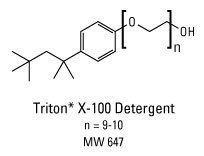Formula C14H22O(C2H4O)n(n=9-10) Appearance viscous colourless liquid | Density 1.07 g/cm³ | |
 | ||
Triton x 100
Triton X-100 (C
14H
22O(C
2H
4O)n) is a nonionic surfactant that has a hydrophilic polyethylene oxide chain (on average it has 9.5 ethylene oxide units) and an aromatic hydrocarbon lipophilic or hydrophobic group. The hydrocarbon group is a 4-(1,1,3,3-tetramethylbutyl)-phenyl group. It is closely related to IGEPAL CA-630 or erstwhile Nonidet P-40, which might differ from it mainly in having slightly shorter ethylene oxide chains. Thus Triton X-100 is slightly more hydrophilic than Igepal CA-630; these two detergents may not be considered to be functionally interchangeable for most applications. Triton X-100 was originally a registered trademark of Rohm & Haas Co. It was subsequently purchased by Union Carbide and then acquired by Dow Chemical Company upon the acquisition of Union Carbide. Soon afterward (in 2009), Dow also acquired Rohm & Haas Co. Other trademarks for very similar compounds include Conco NI, Dowfax 9N, Igepal CO, Makon, Neutronyx 600's, Nonipol NO, Plytergent B, Renex 600's, Solar NO, Sterox, Serfonic N, T-DET-N, Tergitol NP, Triton N etc.
Contents
Triton X detergents are distantly related to Pluronic range of detergents marketed by BASF. The pluronics are triblock copolymers of ethylene oxide and propylene oxide with the ethylene oxide segments being more hydrophilic than the propylene oxide.
1 x cmc triton x 100 jet into air 5 000 fps
Physical properties
Undiluted Triton X-100 is a clear viscous fluid (but less viscous than undiluted glycerol) owing to the hydrogen bonding of its hydrophilic polyethylene oxide parts. Undiluted Triton X-100 has a viscosity of about 270 centipoise at 25 °C which comes down to about 80 centipoise at 50 °C. Triton X-100 is soluble at 25 °C in water, toluene, xylene, trichloroethylene, ethylene glycol, ethyl ether, ethyl alcohol, isopropyl alcohol, ethylene dichloride, but unless a coupling agent like oleic acid is used, Triton X-100 is insoluble in kerosene, mineral spirits, and naphtha.
Uses
Triton X-100 is a commonly used detergent in laboratories. Triton X-100 is widely used to lyse cells to extract protein or organelles, or to permeabilize the membranes of living cells.
Some applications include
Apart from laboratory use, Triton X-100 can be found in several types of cleaning compounds, ranging from heavy-duty industrial products to gentle detergents. It is also a popular ingredient in homemade vinyl record cleaning fluids together with distilled water and isopropyl alcohol. It is a good micellar catalyst.
